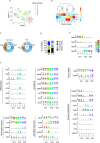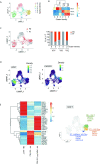Intrahepatic CD69+Vδ1 T cells re-circulate in the blood of patients with metastatic colorectal cancer and limit tumor progression
- PMID: 35863820
- PMCID: PMC9310256
- DOI: 10.1136/jitc-2022-004579
Intrahepatic CD69+Vδ1 T cells re-circulate in the blood of patients with metastatic colorectal cancer and limit tumor progression
Abstract
Background: More than 50% of all patients with colorectal cancer (CRC) develop liver metastases (CLM), a clinical condition characterized by poor prognosis and lack of reliable prognostic markers. Vδ1 cells are a subset of tissue-resident gamma delta (γδ) T lymphocytes endowed with a broad array of antitumor functions and showing a natural high tropism for the liver. However, little is known about their impact in the clinical outcomes of CLM.
Methods: We isolated human γδ T cells from peripheral blood (PB) and peritumoral (PT) tissue of 93 patients undergone surgical procedures to remove CLM. The phenotype of freshly purified γδ T cells was assessed by multiparametric flow cytometry, the transcriptional profiles by single cell RNA-sequencing, the functional annotations by Gene Ontology enrichment analyses and the clonotype by γδ T cell receptor (TCR)-sequencing.
Results: The microenvironment of CLM is characterized by a heterogeneous immune infiltrate comprising different subsets of γδ tumor-infiltrating lymphocytes (TILs) able to egress the liver and re-circulate in PB. Vδ1 T cells represent the largest population of γδ TILs within the PT compartment of CLM that is greatly enriched in Vδ1 T effector (TEF) cells expressing constitutive high levels of CD69. These Vδ1 CD69+ TILs express a distinct phenotype and transcriptional signature, show high antitumor potential and correlate with better patient clinical outcomes in terms of lower numbers of liver metastatic lesions and longer overall survival (OS). Moreover, intrahepatic CD69+ Vδ1 TILs can egress CLM tissue to re-circulate in PB, where they retain a phenotype, transcriptional signature and TCR clonal repertoires resembling their liver origin. Importantly, even the increased frequencies of the CD69+ terminally differentiated (TEMRA) Vδ1 cells in PB of patients with CLM significantly correlate with longer OS. The positive prognostic score of high frequencies of CD69+ TEMRA Vδ1 cells in PB is independent from the neoadjuvant chemotherapy and immunotherapy regimens administered to patients with CLM prior surgery.
Conclusions: The enrichment of tissue-resident CD69+ Vδ1 TEMRA cells re-circulating at high frequencies in PB of patients with CLM limits tumor progression and represents a new important clinical tool to either predict the natural history of CLM or develop alternative therapeutic protocols of cellular therapies.
Keywords: T-lymphocytes; immunity, cellular; immunologic surveillance; liver neoplasms; lymphocytes, tumor-infiltrating.
© Author(s) (or their employer(s)) 2022. Re-use permitted under CC BY-NC. No commercial re-use. See rights and permissions. Published by BMJ.
Conflict of interest statement
Competing interests: None declared.
Figures







Similar articles
-
Chemotherapy accelerates immune-senescence and functional impairments of Vδ2pos T cells in elderly patients affected by liver metastatic colorectal cancer.J Immunother Cancer. 2019 Dec 11;7(1):347. doi: 10.1186/s40425-019-0825-4. J Immunother Cancer. 2019. PMID: 31829255 Free PMC article.
-
NKp46-expressing human gut-resident intraepithelial Vδ1 T cell subpopulation exhibits high antitumor activity against colorectal cancer.JCI Insight. 2019 Dec 19;4(24):e125884. doi: 10.1172/jci.insight.125884. JCI Insight. 2019. PMID: 31689241 Free PMC article.
-
Human intestinal Vdelta1+ lymphocytes recognize tumor cells of epithelial origin.J Exp Med. 1996 Apr 1;183(4):1681-96. doi: 10.1084/jem.183.4.1681. J Exp Med. 1996. PMID: 8666926 Free PMC article.
-
Human γδ T cells in the tumor microenvironment: Key insights for advancing cancer immunotherapy.Mol Cells. 2025 Feb;48(2):100177. doi: 10.1016/j.mocell.2025.100177. Epub 2025 Jan 6. Mol Cells. 2025. PMID: 39778860 Free PMC article. Review.
-
Cancer immunotherapy with γδ T cells: many paths ahead of us.Cell Mol Immunol. 2020 Sep;17(9):925-939. doi: 10.1038/s41423-020-0504-x. Epub 2020 Jul 22. Cell Mol Immunol. 2020. PMID: 32699351 Free PMC article. Review.
Cited by
-
CD69 is a Promising Immunotherapy and Prognosis Prediction Target in Cancer.Immunotargets Ther. 2024 Jan 9;13:1-14. doi: 10.2147/ITT.S439969. eCollection 2024. Immunotargets Ther. 2024. PMID: 38223406 Free PMC article. Review.
-
The emerging roles of γδ T cells in cancer immunotherapy.Nat Rev Clin Oncol. 2023 Mar;20(3):178-191. doi: 10.1038/s41571-022-00722-1. Epub 2023 Jan 9. Nat Rev Clin Oncol. 2023. PMID: 36624304 Review.
-
Transcriptomic profile of TNFhigh MAIT cells is linked to B cell response following SARS-CoV-2 vaccination.Front Immunol. 2023 Jul 26;14:1208662. doi: 10.3389/fimmu.2023.1208662. eCollection 2023. Front Immunol. 2023. PMID: 37564651 Free PMC article.
-
Expansion of memory Vδ2 T cells following SARS-CoV-2 vaccination revealed by temporal single-cell transcriptomics.NPJ Vaccines. 2024 Mar 20;9(1):63. doi: 10.1038/s41541-024-00853-9. NPJ Vaccines. 2024. PMID: 38509155 Free PMC article.
-
Local γδ T cells: translating promise to practice in cancer immunotherapy.Br J Cancer. 2023 Aug;129(3):393-405. doi: 10.1038/s41416-023-02303-0. Epub 2023 Jun 13. Br J Cancer. 2023. PMID: 37311978 Free PMC article. Review.
References
-
- Fehlings M, Jhunjhunwala S, Kowanetz M, et al. . Late-differentiated effector neoantigen-specific CD8+ T cells are enriched in peripheral blood of non-small cell lung carcinoma patients responding to atezolizumab treatment. J Immunother Cancer 2019;7:249. 10.1186/s40425-019-0695-9 - DOI - PMC - PubMed
Publication types
MeSH terms
Substances
LinkOut - more resources
Full Text Sources
Medical
Molecular Biology Databases
